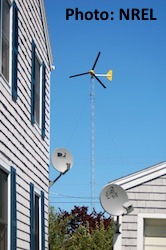Small wind turbines will now have to be certified by the U.S. Internal Revenue Service (IRS) who has issued Notice 2015-4 providing new performance and quality standards that require certification of small wind turbines. “Small” turbines are classified as those having a nameplate capacity of up to 100 KW and must fit into this category in order to qualify for the 30 percent federal Investment Tax Credit (ITC).
“Distributed wind power for homes, farms, and small business is generating clean, affordable and homegrown electricity across all 50 states and as the market grows, it’s of critical importance to ensure high quality products make it to market,” said Jennifer Jenkins, executive director of the Distributed Wind Energy Association. “These certification requirements provide performance and quality assurance for consumers, government agencies and the industry, and help to ensure the successful implementation of distributed wind projects domestically.”
 The IRS certification goes into effect for small wind turbines acquired or placed in service after January 26, 2015. The guidance requires that qualifying small wind manufacturers provide certification to either: (1) American Wind Energy Association Small Wind Turbine Performance and Safety Standard 9.1-2009 (AWEA); or (2) International Electrotechnical Commission 61400-1, 61400-12, and 61400-11 (IEC). The certification must be issued by an eligible certifier, which is defined as a third party, that is accredited by the American Association for Laboratory Accreditation or other similar accreditation body. Documentation establishing that the turbine meets the new requirements must be provided to taxpayers in order to claim the credit.
The IRS certification goes into effect for small wind turbines acquired or placed in service after January 26, 2015. The guidance requires that qualifying small wind manufacturers provide certification to either: (1) American Wind Energy Association Small Wind Turbine Performance and Safety Standard 9.1-2009 (AWEA); or (2) International Electrotechnical Commission 61400-1, 61400-12, and 61400-11 (IEC). The certification must be issued by an eligible certifier, which is defined as a third party, that is accredited by the American Association for Laboratory Accreditation or other similar accreditation body. Documentation establishing that the turbine meets the new requirements must be provided to taxpayers in order to claim the credit.
Jenkins continued, “The new certification requirement addresses the small, but persistent segment at the fringe of the industry that make wild assertions on efficiency, performance, and the their special ability to work on buildings or very short towers. Now, in order to qualify for the federal tax credits, they will have to prove these claims to third-party experts. That will be very challenging or impossible for unproven designs with exaggerated performance, but will not pose a major barrier for the industry leaders.”
“As an industry, we have been working for many years to strengthen the credibility and reliability of our products,” added Jenkins. “I’m proud to note that our membership has been leading the way on this front, actively pursuing certification since 2010 and poised to comply with these new standards.”

